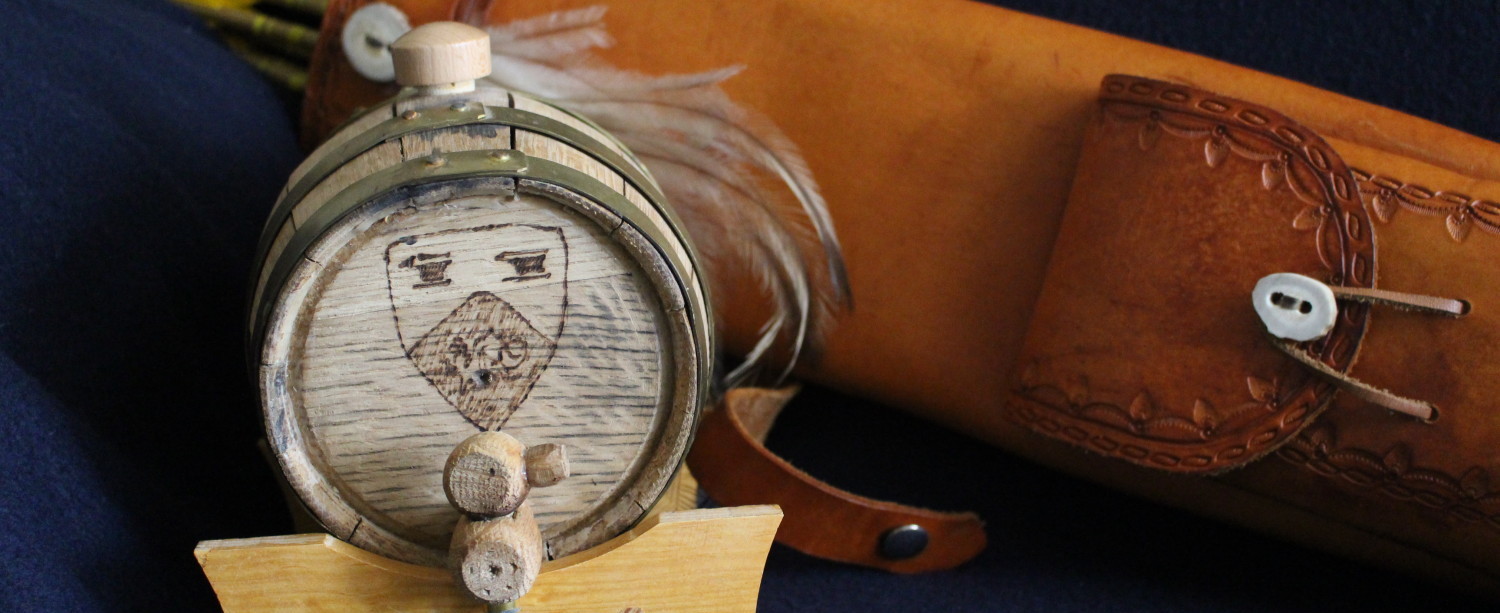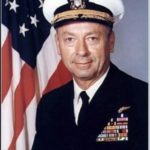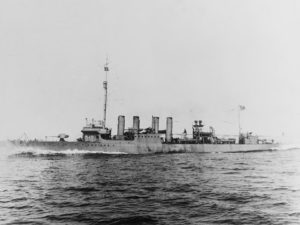Mid-Watch in Verse: USS Overton (DD-239)
This is a continuation of the Mid-Watch in Verse series. A Deck Log from a US Navy vessel chronicles exacting administrative detail regarding the status of the ship, its location, speed, etc. However, for a four hour period at the beginning of each year, the Officer of the Deck (OOD) is allowed to be creative by writing the Mid-Watch report (0000 – 0400) in verse if they choose to do so. This series highlights examples of this tradition and the officers who posted them. I focus on WWII era deck logs. For a more thorough history of the practice check out this article from the Naval History and Heritage Command.
Midwatch in Verse is now available as a book that features poems from 29 ships during WWII. See the book’s website for details.
The USS Overton (DD-239) was a Clemson-class destroyer commissioned in 1920. She was decommissioned in 1931, only to be recommissioned in 1932. Decommissioned again in 1937 and recommissioned for a second time in 1939, she was reclassified as a high speed transport (APD-23) in August of 1943. She was finally struck from the Navy’s rolls in 1945.
From commissioning until WWII, Overton traveled between the US and Europe on various diplomatic and humanitarian missions. After her recommissioning in 1939 when hostilities broke out in Europe, Overton provided antisubmarine services for convoys crossing the Atlantic. After being reclassified as a high speed transport in 1943, she sailed to the Pacific and participated in several of the major campaigns of 1944 and 1945 (including Saipan, Tinian, Iwo Jima, Okinawa, and the liberation of the Philippines). The Navy struck Overton from the roles in late 1945 and she was sold for scrap. She earned 8 battle stars for her service.
The following deck log entry for mid-watch, January 1, 1943, was penned by then Lt. Malcolm Winfield Cagle. The entry is short and in rhyming verse. It is unusual for its lack of operational details that most Officers of the Deck (OOD) tried to incorporate into their log entries. The actual deck log can be seen here.
0 – 4 Nineteen hundred and forty two, Remembered as a thing we knew,
With many tears and lots of grief, For people with a firm belief.
Another year we start anew, With growing hate it’s all too true,
We hope this year to find relief, And give to hell on great big thief.M Cagle
Malcolm Winfield Cagle (often referred to as “Chris”) was born on September 26, 1918, in Grand Junction, CO. He graduated from Knoxville (TN) High School and received an appointment to the Naval Academy at Annapolis in 1937 (Cagle’s entry in the Annapolis Lucky Bag can be seen here and here). Graduating from Annapolis in 1941, Cagle boarded the USS Overton as an ensign for his first assignment. Five days after he penned the log entry above, he transferred off the Overton to aviation training at Pensacola, FL, and in August of 1943 got his Naval Aviator designation.
By 1944, after a stint as a flight instructor, Cagle was dispatched to the USS Yorktown (CV-10) as Executive Officer of Fighting Squadron 88 (VF-88). He rose to command the squadron when on July 14, 1945, Richard Crommelin, the 88’s commanding officer collided with a friendly plane in bad weather and was never seen again (Crommelin was one of five brothers who graduated from Annapolis and served in the US Navy). Not all of Cagle’s men found him endearing. According to an article published in World War II Magazine, one of his men who revered Crommelin recalled, “Cagle ‘invited’ suggestions from veterans—but his body language made clear he wanted none. He was a bull, no questions asked.”
Cagle’s naval career blossomed over the next 20-30 years. He held many positions including the following:
- Commanding Officer (CO) Fighting Squadron 63 aboard the USS Franklin D.
Roosevelt
- CO USS Suribachi (AE-21) 9 September 1963 – 1 June 1964
- CO USS Franklin D. Roosevelt (CVB-42) 25 July 1964 – 27 August 1965
- Commander, Carrier Division One
- Military Aide to the Secretary of the Navy
- Chief, Naval Education & Training.
Cagle was highly decorated throughout his career, including Navy Cross, Navy Distinguished Service Medal (2), Legion of Merit, and Distinguished Flying Cross. The citations for those medals can be found here.
A prolific writer, Cagle published many articles and books related to naval operations and naval aviation. Some of the books are available via online booksellers (a link to his books on Amazon.com here).
All was not rosy for Admiral Cagle throughout his career, though. Scandal surrounded him late in his tenure as a naval officer and into his retirement. At least three issues arose that called into question whether Admiral Cagle engaged in unethical and/or illegal activities. One scandal involved one of Cagle’s Navy pilots, Duane Blankenship, who claimed that he was dismissed from active service because he complained about Cagle’s personal use of military aircraft. Blankenship took his complaint to his Senator, Pat Schroeder (D-CO), and asked to be reinstated. He claimed that Cagle had him fly on personal business and carry unauthorized family members to their farm in Virginia, cattle shows, and fishing trips. He even alleged that Cagle directed him to fly to Virginia to pick up apples (Idaho State Journal, Pocatello, ID, October 19, 1975) from his farm and deliver them to friends in Pensacola, FL. (Also, see clippings from Pasadena Star News, Pasadena, CA, August 15, 1976, and the Greeley Tribune, Colorado, August 16, 1976). Cagle was ordered to pay restitution of over $5,000 for these flights.
A second scandal led to Cagle receiving a letter of censure for establishing a private bank at the Naval Air Station, Pensacola, FL. According to a New York Times article on October 15, 1975,
The Navy announcement said that Admiral Cagle, both in his official capacity and as a stockholder in the bank “favorably endorsed” to the Navy Controller a request that the Treasury Department approve the establishment of a branch of the First Navy Bank at Sherman Field, which is part of the Pensacola base complex, and invited commanding and executive officers to attend a luncheon paid for by the First Navy Bank where presentations were made in behalf of the bank.
This was considered a conflict of interest, and while not necessarily illegal, it showed a lack of candor and disregard for the optics of engaging in such behavior.
The most serious alleged offense led to a federal indictment of Admiral Cagle and several others on charges to intend to defraud the federal government. It was alleged that he recommended to the Imperial Iranian Navy to use a private company, Lulejian & Associates, to train Iranian Navy personnel and that Cagle and others had a financial interest in that company and would benefit greatly from a contract with Lulejian & Associates. This indictment received national attention from no less than the famous syndicated news columnist Jack Anderson. In November of 1977, Cagle and the others were acquitted on the fraud charges.
Admiral Cagle died on July 13, 2003, in Jackson, MS, at the age of 84. He was buried in Arlington National Cemetery along with his wife, Virginia, who died in 1994, and their four-month old son, James, who died in 1956.




Comments
Mid-Watch in Verse: USS Overton (DD-239) — No Comments
HTML tags allowed in your comment: <a href="" title=""> <abbr title=""> <acronym title=""> <b> <blockquote cite=""> <cite> <code> <del datetime=""> <em> <i> <q cite=""> <s> <strike> <strong>